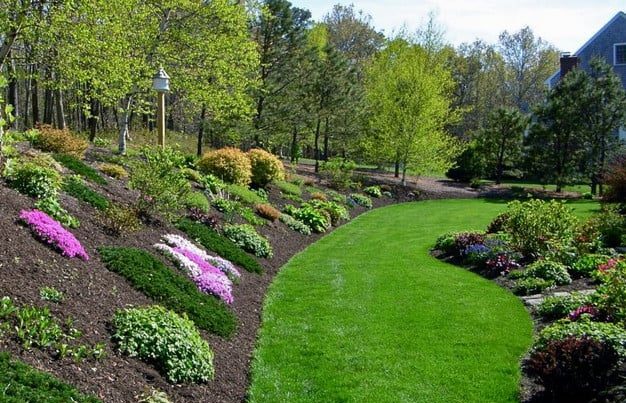Achieve a Beautiful Outside Oasis With Thoughtful Steep Hillside Landscape Design Solutions
Transforming a steep hill right into an exciting outside oasis provides distinct obstacles that need cutting-edge landscape design options. By resolving issues such as erosion control and access, one can develop a harmonious mix of appeal and performance. Strategies such as terracing, the setup of keeping walls, and the option of native plants play vital roles in this process. Additionally, incorporating water features can even more improve the landscape's attraction. Nevertheless, comprehending the details of these elements is important for attaining a genuinely cohesive and welcoming environment. What methods will best suit your hillside's specific attributes?
Understanding Steep Hillside Difficulties
Landscaping on steep hillsides provides one-of-a-kind challenges that need cautious consideration and critical planning. The inclination of the surface can cause concerns such as dirt disintegration, water overflow, and minimal accessibility, every one of which should be addressed to produce a useful and visually pleasing outside space.
Among the main interest in steep hill landscaping is erosion, which can result from heavy rains or improper water drainage. This not only affects plant wellness yet can also jeopardize the security of the slope. Applying effective erosion control measures, such as growing ingrained plants or using compost, is necessary in protecting the integrity of the landscape.
:strip_icc()/SIP948659-72618b298928442798734645f486fed1.jpg)
Designing With Terracing Methods
To alleviate the challenges posed by high hillsides, integrating terracing methods can be a reliable solution. This design approach transforms a sloped landscape right into a series of flat, level areas, creating an aesthetically striking and functional exterior space. Terracing not just assists to avoid soil erosion yet also helps with much better water drainage, which is vital in maintaining the health and wellness of plants and the security of the hill.
The use of indigenous plants on each level can enhance biodiversity, promote sustainability, and decrease upkeep demands. Furthermore, incorporating paths in between terraces can improve ease of access and urge exploration of the landscape.
Terraced gardens can offer several objectives, including vegetable manufacturing, ornamental display screens, or outdoor seats areas. By utilizing materials that mix harmoniously with the surrounding atmosphere, the terracing can boost the total visual allure of the residential property. Eventually, thoughtful terracing changes steep hillsides into functional, lovely rooms that welcome interaction and satisfaction.
Executing Retaining Walls
When encountered with the difficulties of high surface, implementing preserving wall surfaces can give both architectural support and visual enhancement to a landscape. These walls serve to avoid soil erosion, maintain inclines, and develop level locations for horticulture or recreational use. Steep hill landscaping. By properly handling water runoff and his response minimizing soil movement, retaining wall surfaces safeguard your landscape investment while boosting safety

Expert setup is crucial to ensure the longevity and efficiency of preserving wall surfaces. Proper drain systems need to be incorporated to ease hydrostatic pressure, stopping architectural failure. Consulting with landscape specialists will guarantee that the layout lines up with your general vision while sticking to regional policies.
Deciding On Native Plants
Selecting native plants for your landscape layout supplies various ecological and visual advantages. Steep hill landscaping. Indigenous plants are adapted to the local climate and dirt problems, requiring much less water and upkeep compared to non-native varieties. This flexibility not only conserves sources however also advertises a healthier ecological community, as indigenous plants support regional wild animals, consisting of pollinators such as bees and butterflies
Including native vegetation right into your high hill landscape design can boost soil security, reducing disintegration and advertising a well balanced community. Ingrained native plants aid anchor the dirt, making them optimal for sloped areas. Furthermore, these plants frequently exhibit dynamic colors and varied textures, developing a visually enticing landscape that harmonizes with the surrounding environment.
When picking indigenous plants, consider their development behaviors, seasonal interest, and compatibility with other varieties. Grouping plants with similar water and sunshine demands can result in a much more natural why not try these out layout, while likewise streamlining maintenance. By selecting native plants, you not only grow a lasting outdoor oasis yet likewise add favorably to the local biodiversity, ensuring that your landscape grows for years ahead.
Incorporating Water Attributes
Incorporating water functions right into your steep hillside landscape design can substantially enhance both the visual allure and environmental performance of the space. The audio of streaming water creates a calm atmosphere, while aesthetically, it can function as a prime focus that attracts the eye and adds deepness to the landscape.
When picking water features, consider options that match the natural shapes of your hill. Waterfalls, as an useful content example, can cascade the incline, producing visual rate of interest and advertising healthy drain. Fish ponds can additionally be integrated right into the layout, encouraging regional wildlife and offering habitats for various species.
In addition, the placement of plants around these functions is vital. Native water plants not only boost the beauty of the water feature but likewise add to its environmental equilibrium by filtering system contaminants and providing food for regional animals.
Maintenance is another key variable; make certain that your water feature is made for very easy maintenance. An effectively created attribute will need very little intervention, permitting you to appreciate the beauty and harmony it uses without excessive labor. Eventually, thoughtfully bundled water features can transform your steep hill landscape into an exciting exterior oasis.
Verdict
To conclude, changing a steep hillside into a gorgeous outside sanctuary necessitates thoughtful landscape design approaches that deal with disintegration control and availability. The combination of terracing methods, the execution of retaining wall surfaces, and the choice of indigenous plants are important elements of reliable design. In addition, including water features boosts both visual allure and drain performance. With careful preparation and execution, high hillsides can end up being tranquil hideaways that provide both capability and aesthetic joy.